E1 vs SL Tires: 10 Important Factors Compared
Are you in need to elevate your driving experience but confused between E1 Vs SL Tires? Don’t worry! You are in the right place!
In this article, we will delve into their distinctive features, load range, pros and cons, and specific uses. Join us on this thrilling tire exploration journey and let us assist you in making the right choice!
Table of Contents
The Load Range Explained
The load range is used on the tires to describe maximum load durability.
- This term is similar to the ply rating of the tire.
- The tire load rating indicates how much weight a tire can carry. The number of tires and the load capacity of a single tire determine the load range rating.
- The load range runs from A to F, while the ply ratings run from 2 to 12.
Tire load ratings | Ply rating |
A | 2 |
B | 4 |
C | 6 |
D | 8 |
E | 10 |
F | 12 |
However, let’s focus on the Standard load SL tires ( which lie in the B load range ) and the E1 tires (E load range):
- SL: The SL (Standard Load) classification is mostly linked with passenger cars, light trucks, and certain SUVs. The load capacity of SL-rated tires varies depending on tire size and structure, with the tire manufacturer providing particular information.
- E1: The E load range denotes Extra Load; The “E1” load range marking is higher than that of the SL tires. Tires with an E1 tire load rating used on light trucks handle heavy loads and off-road conditions.
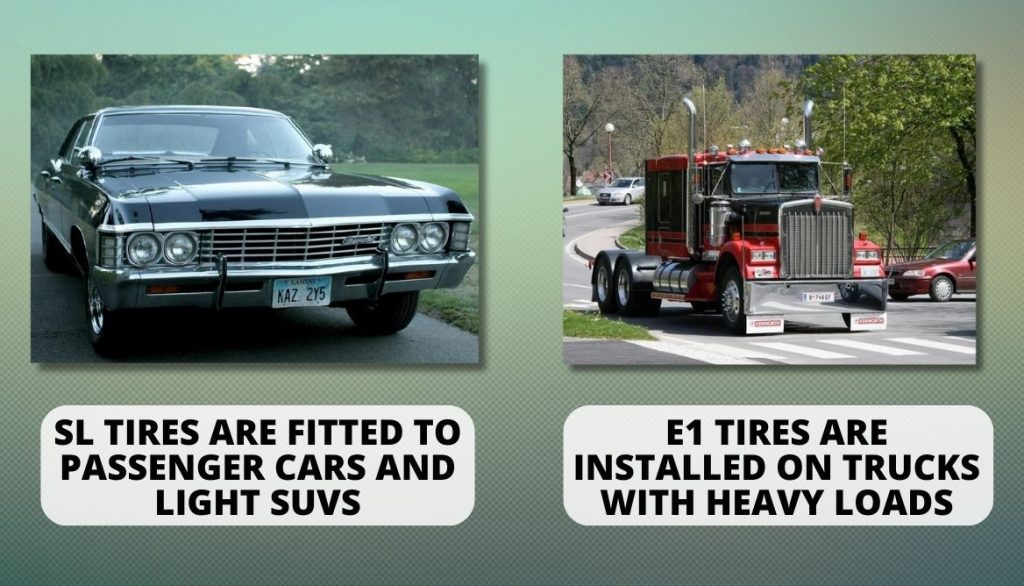
Load Index
A tire’s load index is a two- or three-digit numerical code that indicates the tire’s maximum load capacity. It ensures that the tires can handle the vehicle’s weight, the occupants, and an additional load.
Each load index value corresponds to a particular max load capacity in pounds or kilograms. For instance, a tire with a load index of 95 can carry up to 1,521 pounds (690 kilograms), while a tire with a load index of 110 can handle 2,337 pounds (1,060 kilograms).
Check out the relationship between the speed rating and the load index here.
It’s important to note the following:
- Lower inflation pressure reduces the load-carrying capacity and compromises the tire safety and performance.
- When selecting tires for a vehicle, it is essential to choose tires with a load index that meets the requirements specified by the vehicle manufacturer.
The Ply Rating Explained
The ply rating indicates the strength and load-carrying capacity of a tire. But it is no longer directly linked to its construction and the number of layers it possesses.
Thanks to advancements in tire engineering and materials, it is now possible to achieve higher tire strength and capacity without the need for additional layers.
- Both E1 and SL tire labeling systems no longer use ply ratings as a direct indicator of tire construction.
- Instead, they rely on the load rating, load index, haul range, and speed rating to provide information about a tire’s capabilities.
You can check out the ply rating here.
- E – Rated Tires: E1 tires follow the European Tyre and Rim Technical Organisation (ETRTO) standards. E-rated tires have a ply rating of 10 which corresponds to a load range rating of E.
- Sl Tires: Sl tires represent standard load range tires. They follow the Department of Transportation (DOT) standards used in North America. The SL tires have a ply rating of 4, equal to a load range rating of B.
A Quick Comparison
Let’s quickly examine the main differences between the SL load rating and the E1 load range e tires.
Name: | SL | E1 |
Ply rating: | 4 PLY rating | 10 PLY rating |
Fuel efficiency: | Better fuel efficiency on the car | The car consumes more fuel due to the weight capacity |
Weight: | 44 pounds | 52 pounds |
Air pressure: | 36 PSI | 80 PSI |
Load Capacity: | 1477 pounds | 3200 pounds |
Application: | Used on light passenger vehicles in normal road conditions | Used to tow heavy loads and in off-road conditions |
Road comfort: | Offers a smoother and more comfortable ride | They have a stiffer ride due to their reinforced construction |
Construction: | Standard construction suitable for regular passenger vehicles | Reinforced construction with stronger sidewalls to support the increased weight and provide durability |
SL Tires: A Comprehensive Analysis
This comprehensive analysis of the Standard Load (SL) and E1 tires will delve into various aspects, including the pros and cons, towing, and driving capabilities. Check it out.
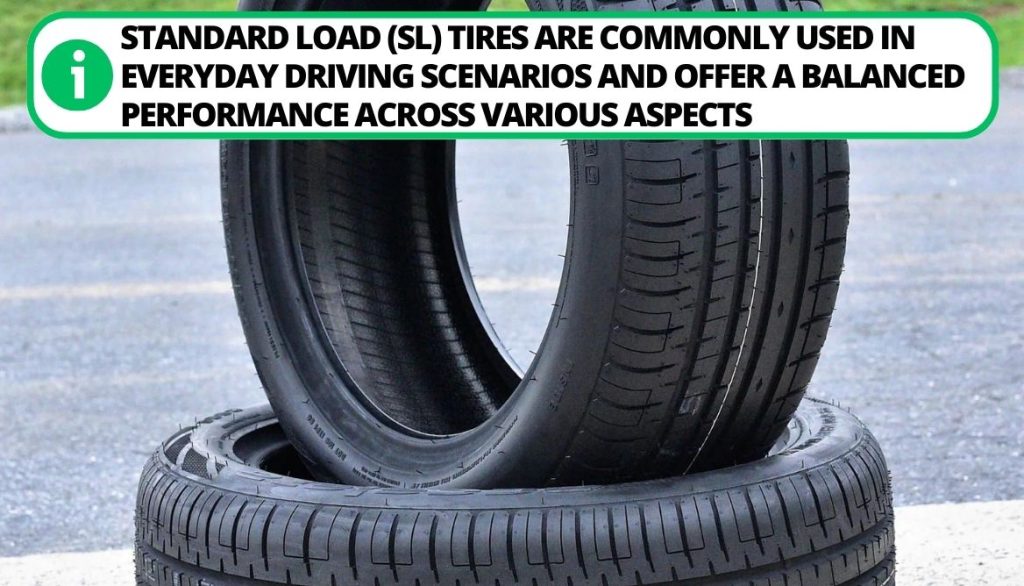
SL Tires: Pros and Cons
Standard Load (SL) tires are commonly used in everyday driving scenarios and offer a balanced performance across various aspects. SL Tires can handle a cargo capacity of 1477 – 1520 pounds at 36 Psi. Let’s check their pros and cons:
- Designed to provide a smooth ride due to the reduced vibrations and less noise.
- Many SL tires have a lower rolling resistance, resulting in reduced fuel consumption for vehicles equipped with these tires.
- SL tires are more affordable compared to tires with higher load ranges.
- SL tires have a lower load-carrying capacity when compared to load-e tires.
- Heavy loads or rough terrains can accelerate wear and increase the likelihood of damage to these tires.
Reliability
The lasting duration of SL tires varies depending on driving habits, maintenance, road conditions, and tire quality:
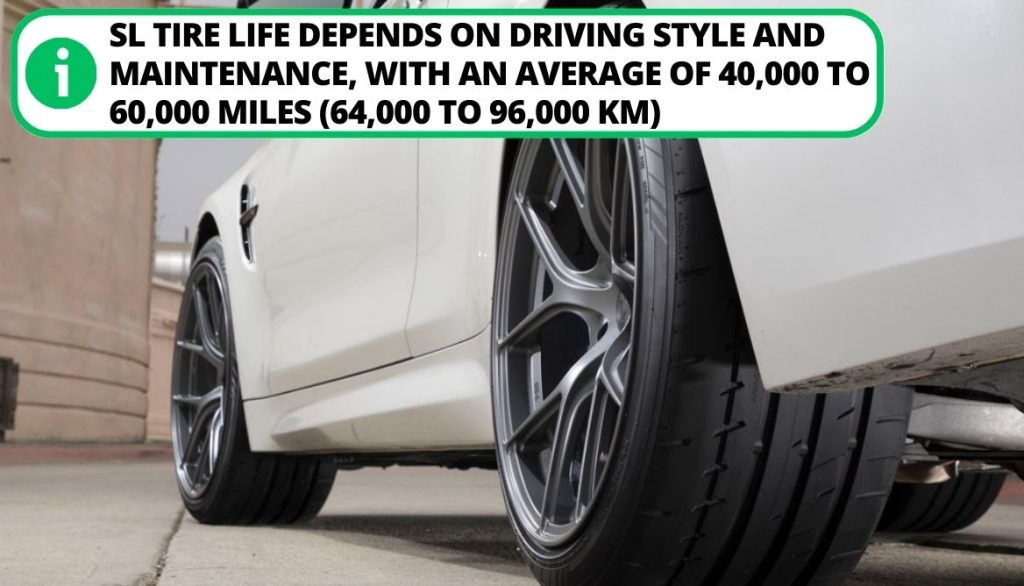
- Some tires have the potential to last for around 40,000 to 60,000 miles (64,000 to 96,000 kilometers) before requiring replacement.
- With proper care and regular maintenance, proper inflation, rotation, and alignment, SL tires can offer you a good lifespan in terms of mileage.
Driving Capabilities
Standard load SL tires provide a good balance of performance characteristics for everyday driving.
- They offer adequate traction, handling, and braking capabilities on dry and wet surfaces.
- However, they may have limitations in extreme weather conditions, such as heavy snow or ice, where specialized tires like winter or all-season tires would be more suitable.
Towing Capabilities
SL tires have limitations in towing heavy loads, but they can still handle moderate towing tasks such as towing lightweight campers or utility trailers.

- They are typically only recommended for towing heavy trailers or loads within their specified ratings.
- Selecting tires with a higher load range that can handle the specific towing requirements is crucial.
E1 Tires: A Comprehensive Analysis
Now let’s take a look at the E1 tires comprehensive analysis.
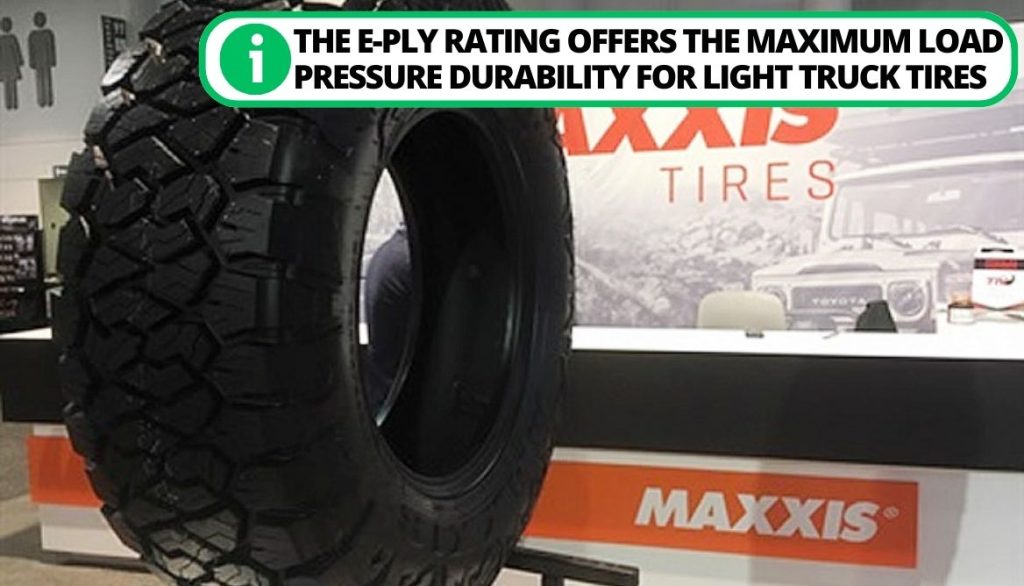
E1 Tires: Pros and Cons
The E-ply rating offers the maximum load pressure durability for Light truck tires. This optimizes the vehicle performance, the tire load-carrying capacity, and the surface grip without hindering the tire’s durability.
Let’s check out their major’s pros, cons, and capabilities:
- E1 tires excel in handling heavier loads, making them an ideal choice for larger vehicles and trucks.
- E1 tires offer unparalleled durability and exceptional resistance to punctures. This makes them well-suited for rugged terrains.
- The sturdy build of E1 tires ensures heightened stability and superior handling and traction.
- E1 tires have an increased rigidity which maintains stability, enhances cornering performance and overall maneuverability.
- The ability to provide reliable and responsive braking enhances the driver’s confidence.
- E1 tires have a stiffer ride compared to tires with lower load ranges, which can result in a less comfortable driving experience.
- An increase in the weight and mass of the tire leads to more fuel consumption.
- Increased noise levels: They generate 1 dB (decibel) more noise than other tires.
- E1 tires are more expensive than lower-load range tires due to the specialized construction.
Lasting Duration
E-load tires are known for their longevity and durability. Proper maintenance and regular rotation can provide a longer-lasting tread life than tires with lower load ranges.
Driving Capabilities
E1 tires provide stability, traction, and control, particularly when carrying heavy loads or driving on challenging surfaces.
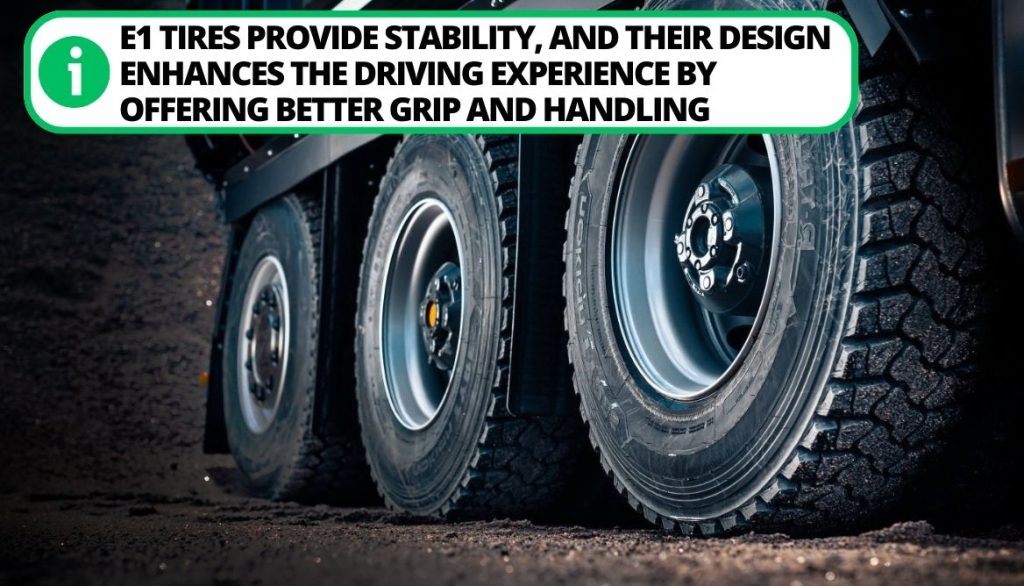
Their sturdy construction enhances driving capabilities by offering better grip and handling.
Towing Capabilities
E1 tires are ideal for towing situations. They provide the necessary strength and balance to withstand the additional weight and stress of hauling huge cargo.
When the light truck tires are properly inflated to 80 PSI, they can handle 3200 pounds per tire; hence, E1 tires are a recommended choice for vehicles involved in towing operations.
E1 And SL Tires: Key Differences
Load Range E1 and SL are two different load range classifications used for tires. Each has distinct characteristics and purposes. Let’s examine the differences between Load Range E1 and SL:
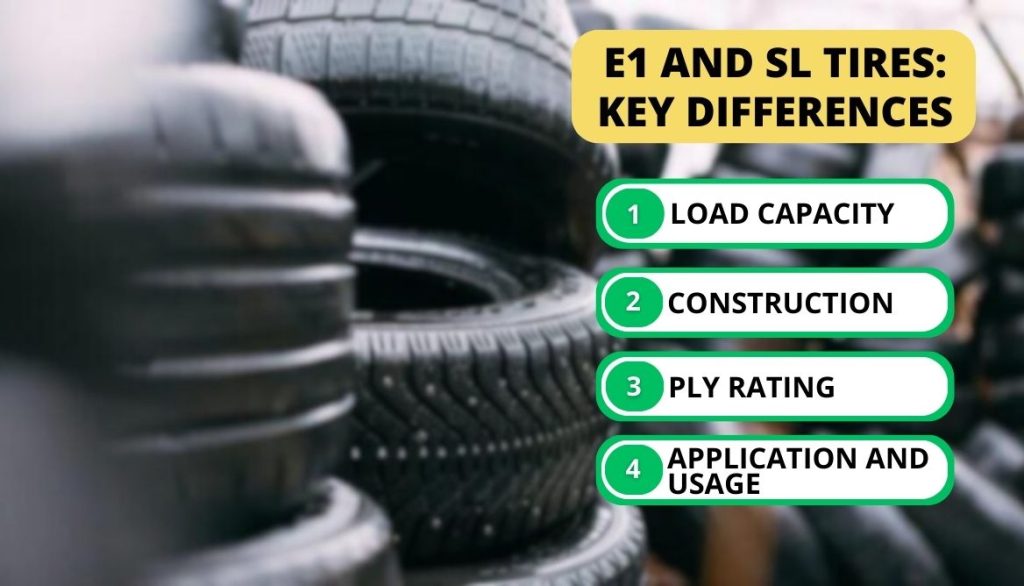
1. Load Capacity
There are distinct differences between the two tires. The E1 tire offers a higher load capacity than the SL tire. To elaborate further, let’s delve into the specific details of each tire.
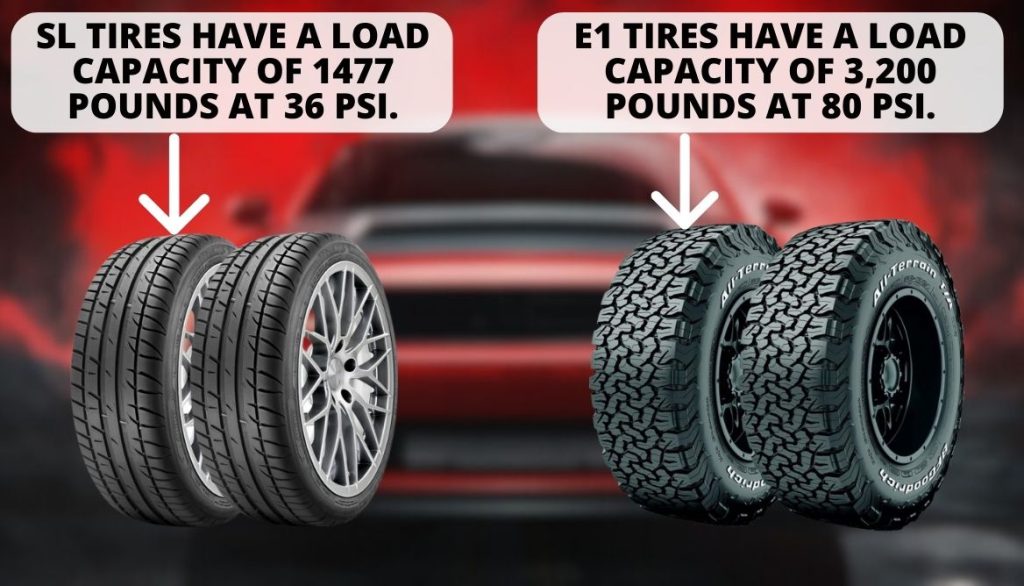
- Load Range E1 tires: Load Range E1 tires are designed to handle heavy-duty applications due to their higher load capacity. TheE1 tires have a load capacity of 3200 pounds at 80 Psi.
- SL (Standard Load): SL tires have a lower load capacity than E1 tires. They have a load capacity of 1477 pounds at 36 Psi.
2. Construction
When comparing the construction of the E1 and SL tires, there are notable differences to consider. Let’s delve into the specific characteristics of each tire type.
- Load Range E1: The E1 tire is constructed using advanced technology and materials, allowing for a high level of strength and durability. It features reinforced sidewalls and optimized tread patterns which ensure improved traction and stability on various road surfaces, making it an excellent choice for on-road and off-road driving.
- SL (Standard Load): SL tires generally have a standard construction suitable for regular load requirements. The SL tire utilizes lightweight materials to reduce rolling resistance and enhance fuel efficiency which leads to improved mileage. The casing design of the SL tire is optimized for improved comfort and reduced road noise.
3. Ply Rating
The Ply rating of the tire is a direct indicator of the load rating which is a key factor when determining strength. let’s explore how the ply rating sets the E1 and SL tires apart:
- Load Range E tires: These are characterized by a 10-ply rating: their construction provides comparable strength to a tire with an actual 10-ply structure. The 10-ply rating is similar to an E-load rating.
- SL Tires: the standard load tires have a 4-ply rating indicating a comparable strength equal to a 4-rubber-ply structure. The 4-Ply rating is similar to the B load rating.
4. Application and Usage
The application of E1 and SL are follows:
- E1 tires: Used in vehicles that carry substantial loads or operate in challenging conditions, such as delivery trucks, construction machines, and commercial vans.
- SL (Standard Load): SL tires suit standard passenger vehicles and light-duty applications. They are common in sedans, Sport Utility Vehicles and minivans. SL tires offer a balance of performance and comfort.
Our Verdict
Both the standard load tires and the E1-rated tires have shown their reliability, although their performance depends on your specific usage.
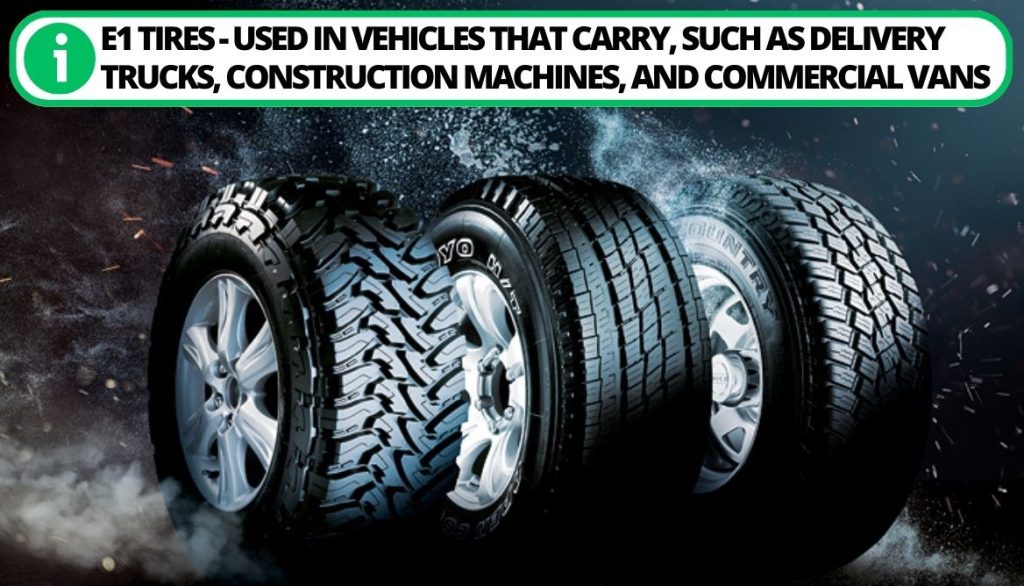
- For those who prioritize speed, road comfort, and fuel efficiency, the SL tires are a recommended choice. They excel in sedans, passenger vehicles, and mid-size SUVs.
- On the other hand, if your primary focus is off-road driving, carrying heavy loads, towing other vehicles, and enhanced traction, the E1-rated tires are an excellent option. They are specifically designed to tackle off-road conditions and offer improved grip and stability in challenging terrains.
FAQ
What does E1 mean on a tire?
The E rating represents the load rating of the tire. An E1 tire load rating indicates that the tire has a 10-ply strength, can handle up to 3200 pounds, and has a maximum air pressure of 80 PSI.
What does SL mean on tires?
SL represents the “Standard Load.” Tires with an SL rating meet the load-carrying requirements of passenger vehicles, light trucks, and some SUVs. SL tires have a load-carrying capacity of 1,477 lbs at 36 Psi.
What is the E1 rating?
An E1 rating is a tire rating designed to indicate load capacity. The E1 rating shows a tire can handle up to 3200 lbs at 80 PSI air pressure.
What ply is an SL tire?
An SL tire has a 4-ply rating which means it has a strength equivalent to 4 layers of rubber on the tire.
Are E-rated tires good?
Yes, E-rated tires are perfect due to their ability to handle heavy loads, durability and ability to withstand stress.
Conclusion
We have uncovered the structural variances between E1 and SL tires, examined their driving and towing capabilities, and identified the ideal scenarios where each excels. The E1 tires have an excellent towing capability, while the SL tires excelled in their driving capabilities.
Have you had any personal experiences with E1 or SL tires? What would you consider when choosing tires for your vehicle? Leave a comment below and join the conversation as we navigate the ever-evolving world of automotive tires.

I`m a current Law Enforcement Officer working within the Counterterrorism Bureau in New York State. I have been Camping for over 20 years. My styles of camping include tent, car, truck, van, and RV travel trailer. I have a YouTube channel where I teach all types of camping with an entertaining method: https://youtube.com/@TheSmallsRVAdventures

![Top 15 Best TVs for RV [Buying Guide]](https://camperlife.co/wp-content/uploads/2021/03/best-tv-rv.png)

![Top 8 Best RV Sofa Beds [Buying Guide]](https://camperlife.co/wp-content/uploads/2021/02/best-rv-sofa-768x512.jpg)


![Top 10 Best RV Wi-Fi Boosters [Detailed Reviews]](https://camperlife.co/wp-content/uploads/2021/02/best-rv-wifi-booster-768x402.png)